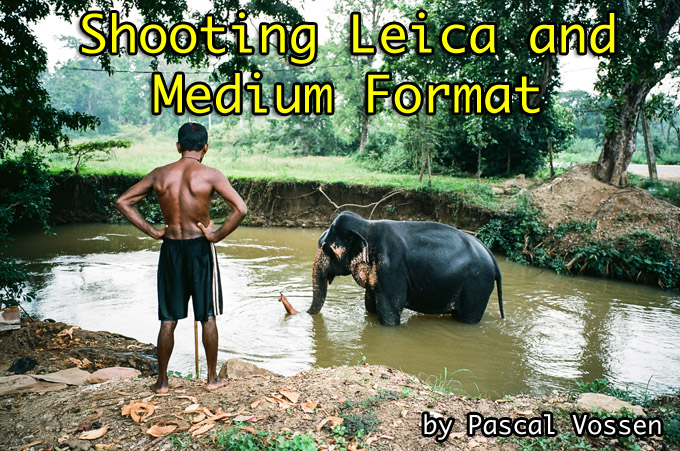
Shooting Medium Format alongside Leica M for Travel and Documentary Photography
by Pascal Vossen
Hi Steve, thank you for your contribution to the photographic community and giving me the chance to ventilate my thoughts to other photographers!
Shooting medium format alongside 35mm format is what I did during my latest trip to Sri Lanka and it turned out really well for me. I enjoyed it a lot and it made sense to me before I left, during shooting and afterwards when I looked at the results. The only ‘regret’ I got is that I didn’t go bigger in film size. Still though, the Leica M was and will remain to be my main travel and documentary camera. Let me first tell you why, before I move on to the medium format part;
[ad#Adsense Blog Sq Embed Image]
Photographing with a Leica M is special. I don’t have to explain that to someone who handled a Leica M before, but to the photographer who didn’t. It’s a camera with a magic feel, handling and character to it. It gives you the best of 35mm in a small and intuitive package. You don’t feel like you are getting blocked off to what is happening around you as soon as you bring the camera to your eye. The design of the Leica M, being a rangefinder camera (i.e. with a separate optical viewfinder), will allow you to stay in contact with what is happening around you. You never loose focus on your subject. You see everything. Notice the light, meter, frame, focus, reframe, anticipate and shoot your image. Its a fast process that always allows you to stay in control. Rangefinder focusing is imo also the most accurate way of focusing, since you don’t have to rely on an auto focus system that might fail. You are in control, you decide where you put the focus. This means that you know exactly where your focus point is. Is this off, then you failed and not the camera.
Leica M7 | 28mm | Portra 400 | Polonaruwa.
Leica M7 | 50mm | Portra 400@800 | Red Mosque, Colombo.
Because of its construction, the fact that it is a rangefinder and thus not has a mirror like a DSLR, the Leica M is compact and elegant. It is without a doubt the most beautiful camera I will ever own. The first time I tried one myself I noticed by its reassuring weight that this thing is build to last. Furthermore, it does not scream for attention and gives most people the impression that you are carrying an ‘old-timer’ around. Yes, sometimes that’s true, but its a very competent ‘old-timer’. But then again even the 2013 Leica M (type 240) still looks like the camera Leica build 30,40 years ago. That is partly the beauty of it and gives its user the freedom to walk around without drawing too much attention to themselves. Even the small time street criminal would more often go for a larger looking plastic DSLR from e.g. one of the Japanese brands, because they think you are holding a worthless old camera that is not worth stealing. If I however go on a trip where I suspect to end up in more dodgy areas I would maybe tape off the ‘Leica’ sign and put some more tape on it to make it look broken, just to make sure. I don’t care what it looks like when I am photographing (I do when its on the shelf ;)). The purpose of having this camera is to be able to get the shots I wouldn’t get with another camera. It is inconspicuous and enables the photographer to get really close without getting noticed. Even the shutter won’t give away your presence when you are photographing with an analog M, since it a cloth shutter and therefore near silent. I have found the digital Leica M (e.g. M8.2 that I also shoot with) in ‘discreet’ mode also very silent until you take your finger of the shutter button and the shutter re-cocks. Prepare yourself to be notices or walk away first.
Leica M7 | 50mm | Portra 400@800 | Temple of the Holy Tooth, Kandy.
Leica M7 | 50mm | Portra 400@800 | Temple of the Holy Tooth, Kandy.
It is my opinion that photographing with a Leica M stimulates you as a photographer to take pictures in a more intelligent way. This has partly to do with the way you frame your images through the viewfinder. The frame lines give you the possibility to anticipate and be in control of the moment. Furthermore, the typical rangefinder character and lenses (prime lenses, mostly ‘wide angle’ to ‘normal’ focal length) force you to come close or be more creative. These are all reasons why the leica M is my main choice for shooting travel and documentary photography.
Leica M7 | 50mm | Portra 400 | Kandy.
Leica M7 | 28mm | Portra 400 | Colombo.
So what made me bring along a medium format camera and why did I think it was a great combination? Let me say this first; Before I left for Sri Lanka I figured out that too many options is no good! I planned on limiting myself to two lenses for the Leica M, the Summicron 28mm F2 for wide angle landscape and environmental portraits and the Summilux 50mm F1.4 ASPH for shots/subjects that are better suited with a normal focal length or less depth of field. But then I threw in a Voigtländer 15mm heliar! I forgive myself since I got some good shots with it.
Then I had the choice of leaving it the way it was, which is a really light travel setup, or fill the bag (i.e. a Billingham Hadley Pro) up with a medium format camera + one standard lens for portrait and landscape. Reasoning behind this was my intention to take close-up portraits and high resolution landscapes. A larger negative means you can capture more information, details and you gain quite a bit of dynamic range (that’s even more true when its digital imo). This and the larger control in depth of field all add to the look of medium format. Nevertheless, the obvious image quality gain was not the surprising part. It was mostly the ease and the way of handling both cameras alongside which I found to be great.
A standard part of my day would be that I would ask my driver to drop me at the beginning of a town/village/city on the way and pick me up a few hours later on the other side. I walked, explored, observed and talked a lot to people. When I saw something interesting I would normally have my Leica M7 in my hand, approach my subject and photograph my subject from the intended angle in the most natural way. This often required me to get pretty close without disturbing them with what they were doing at that particular moment. Would they have noticed me and stopped what they were doing then the image would have been lost. This is definitely important in countries like Sri Lanka where people don’t mind to be photographed and gladly pose with a smile when they notice you. I don’t want that. At least not when its not intended as a portrait. You could consider this ‘phase one’ in the approach to my subject.
Leica M7 | 28mm | Portra 400 | Dambulla.
‘Phase two’ would be approaching my subject for a short chat, making him or her feel comfortable and then ask them if I can take their portrait. If you photograph people in this way you set yourself apart from the average tourist that just snaps away at them and then walks away without saying anything. It really is more or a social and respectable thing to do and you will notice that you will gain a bit of their trust. Just enough to get close enough for an intimate and well-composed portrait.
Contax 645 | Zeiss T* 80mm F2 | Portra 400 | Dambulla.
If you use digital you show the image to them, which could lead to fun reactions and even more photos, or you give them a chance to hand over an email address (if they have that) so you can send them the picture you took of them upon arrival at home. For exactly these kinds of shots I would grab for the medium format camera. I have introduced myself and my intentions to them and I can now take the tool that gives me the largest IQ. Handling the cameras together was great since I could easily tuck away my Leica M and take out the medium format SLR (I used a Contax 645 + 80mm F2). They fitted comfortably in my Billingham Hadley Pro bag, which is not a gigantic bag. It has great padding and with its flat shape it fits perfectly to your body. Another great advantage was that I didn’t have to fumble around and switch lenses on my Leica M the whole time. Switching lenses is a process I find annoying and a little tricky when traveling to dusty and humid places.
So, to sum up what I found great about this setup is;
-Inconspicuousness and intuitive handling with the Leica M
-Advantage of higher IQ from a larger negative (6×4,5> or sensor a-like) when needed.
-It is still a fairly compact setup (Leica M, two lenses and a MF camera) and packs well in a medium sized camera bag (most Medium Format cameras are actually not that big if you think about it).
-It avoids that you have to change lenses when you want to take a portrait or landscape (if you are comfortable using one lens on the medium format camera)
Some more medium format examples:
Contax 645 | Zeiss T* 80mm F2 | Portra 400 | View from Lipton Seat, Haputale.
Contax 645 | Zeiss T* 80mm F2 | Portra 400 | Kandy Bride, Kandy.
Contax 645 | Zeiss T* 80mm F2 | Provia 400X | Near Adams Peak.
Contax 645 | Zeiss T* 80mm F2 | Portra 400 | Mihintale.
Contax 645 | Zeiss T* 80mm F2 | Acros 100 | Galle.
I have found there to only be one possible downside and one ‘regret’ to this all. Downside was that you would have to bring two different formats of film and load two different cameras (if not one or both are digital). The regret was in a way that I didn’t bring a MF camera with a larger negative. That would have been even better. Thus, in the future the MF camera alongside my Leica M will be either a Mamiya 7 or a MF DSLR (Phase One or Hasselblad) depending on the destination, subject/project or way of shooting.
All images are taken in Sri Lanka and the whole series can be viewed on my portfolio (www.pascalvossen.com):
Thank you for reading!
Pascal Vossen

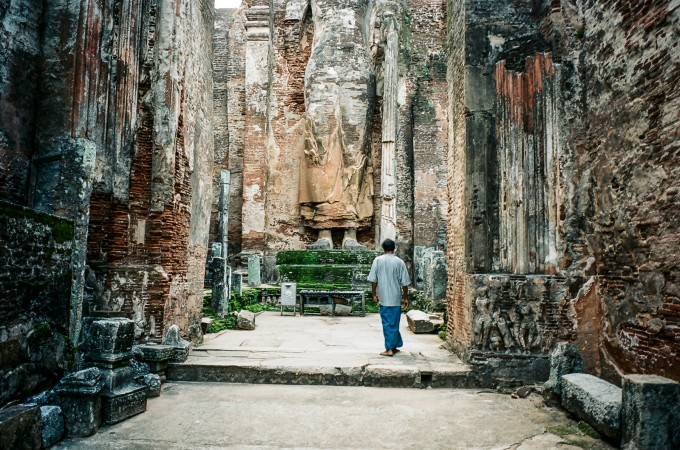
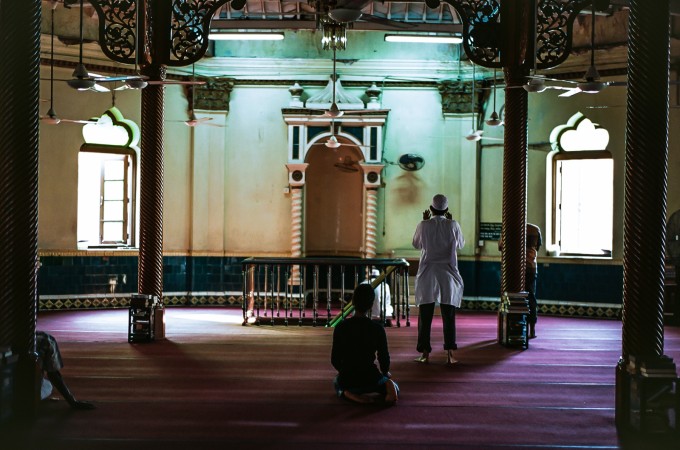
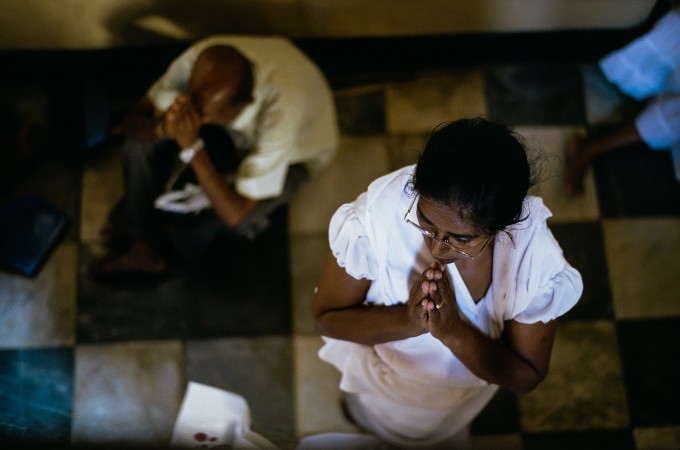
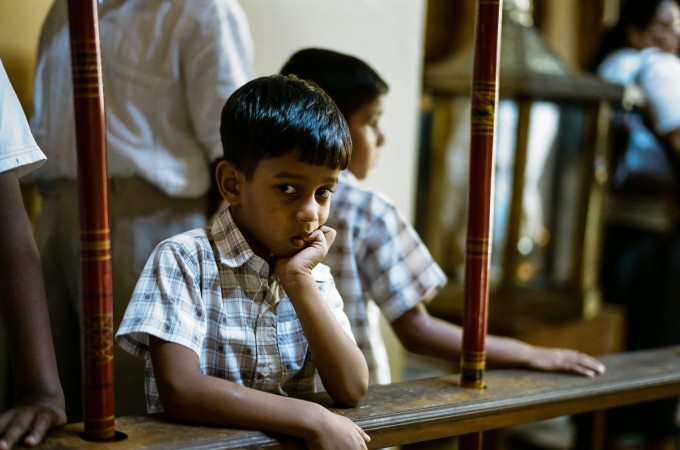
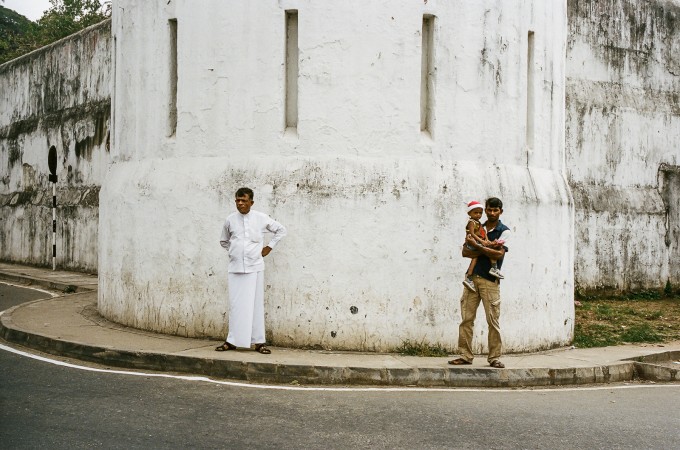
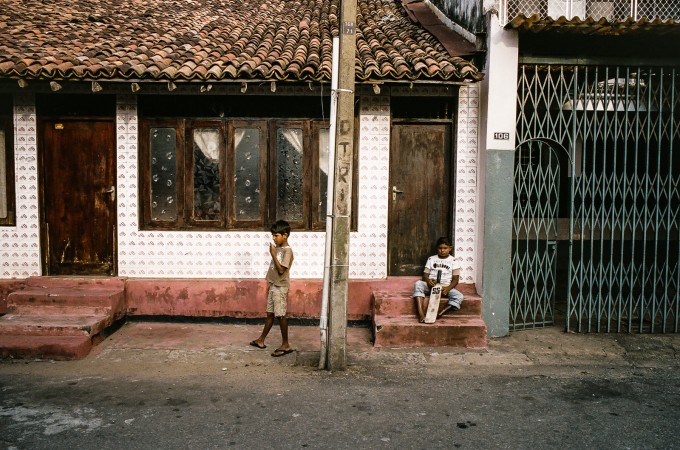
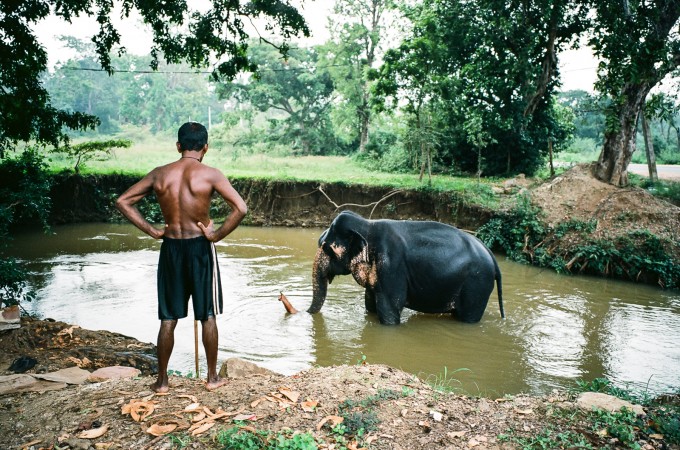
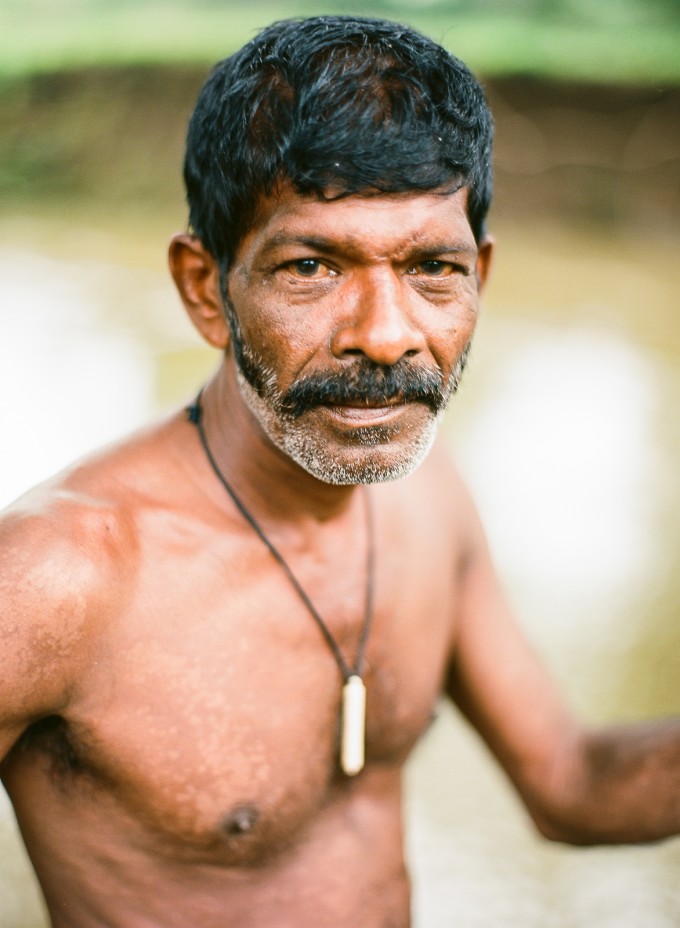
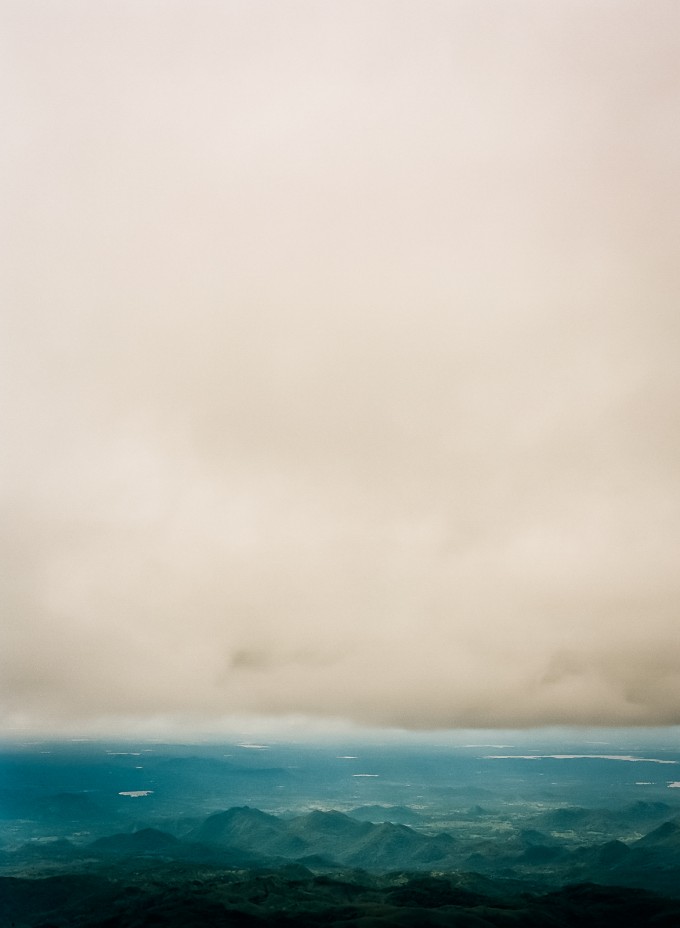
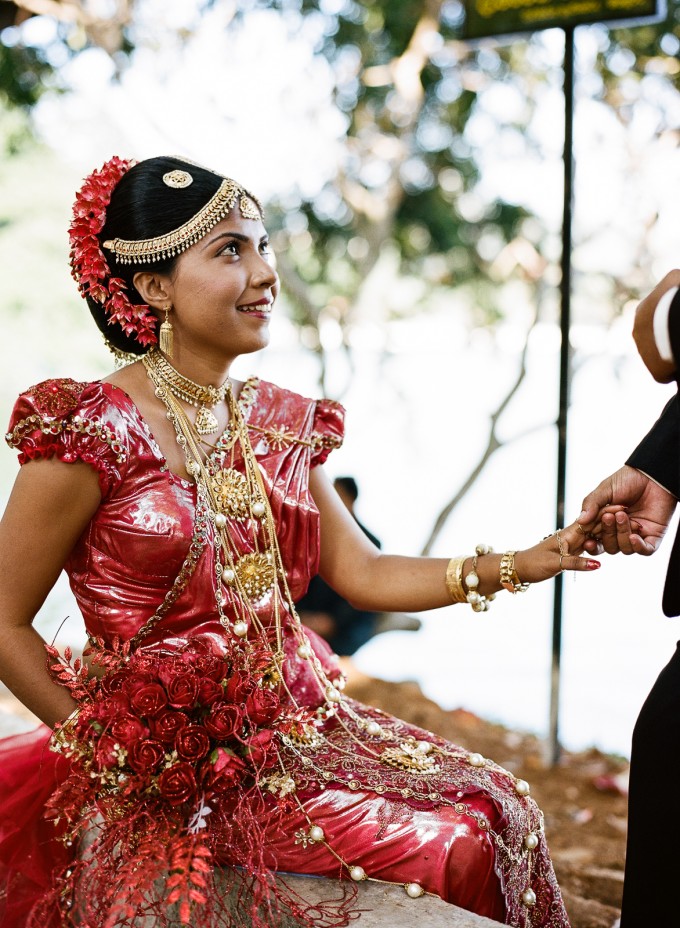
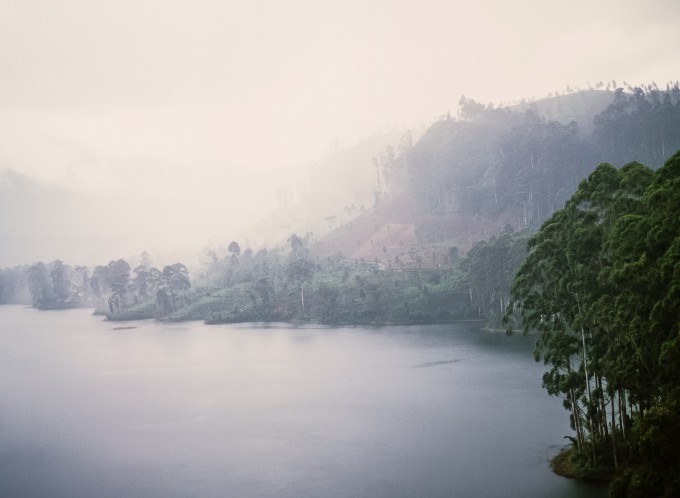
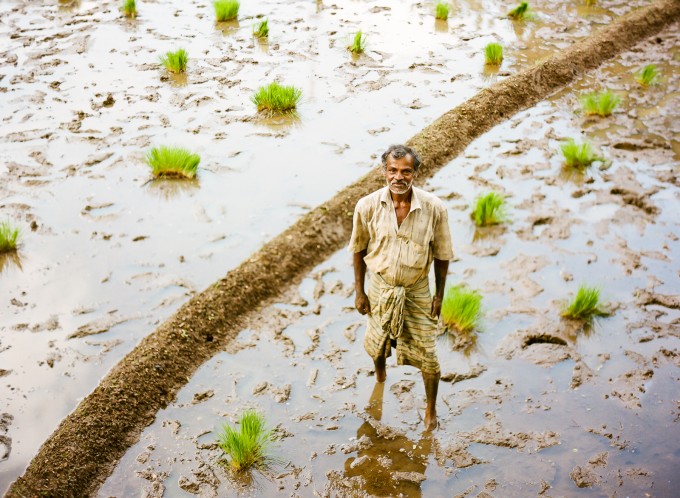
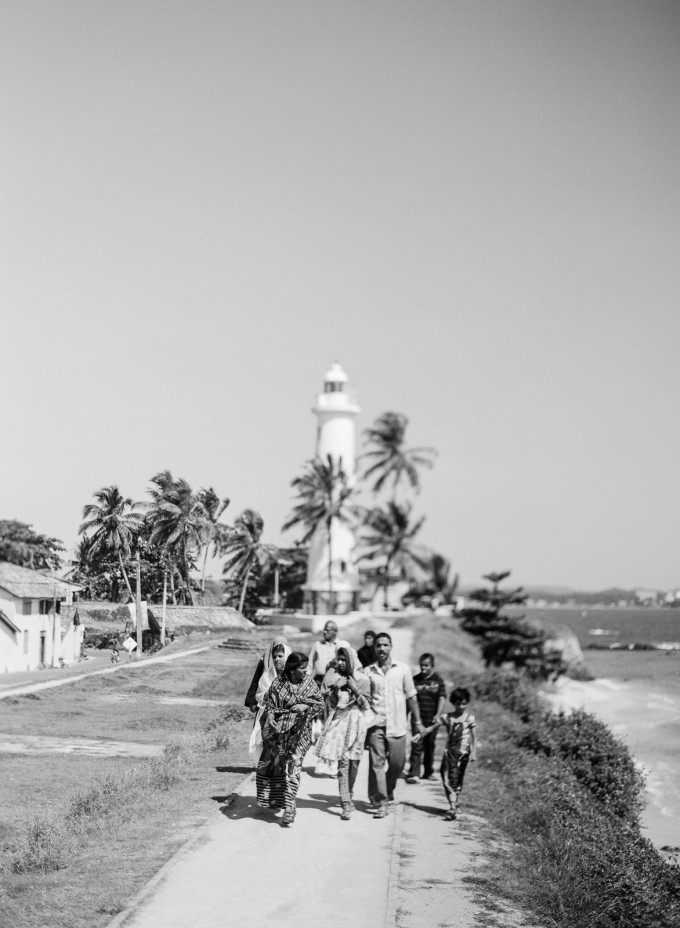

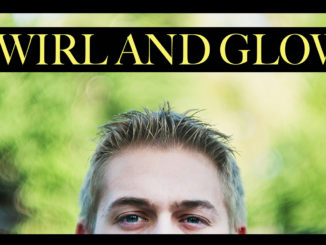
I’ll leave it simply at: wonderful work, inspirational colors.
Pascal, I’m very late to this, but I love the bride in Kandy. I mean they are all good but that one is just a luscious photograph.
Well,
You should definitively check out the natural medium format companions to the Leica M7……the Texas Leica 65 and 90 mm (AKA the Fuji GSW690 and GW690)……same aspect ratio, same mode of operation since rangefinder and with 28 and 35 mm equivalent also the same field of view as most Leica have (in practice).
And image quality wise…..they are on par (using a V750 scanner and Provia) or beat most high end digital backs (with Velvia 50 and a drum scan of course).
Greets, Ed
I am ahead of you Ed 😉 Got a Fuji GW690II and Mamiya 7II + 43/65mm in yesterday. I sold my Contax 645 for it. I really like the rangefinder and I wanted to try the Mamiya. I had tried the GW690II before and I really liked it, the only thing was that the one I bought had a lens flaw and I returned it. I am probably going to miss the Contax 645, but then again I cant’t shoot everything. I am sure I will buy that system again in the future (when prices drop a bit).
Thanks for sharing! Medium format rules, I think it really shines when you make large scale prints. I can imagine the Haputale landscape or the Dambulla elephant shot must be amazing enlarged.
My pleasure! I am still thinking about which one or two to print large (50x70cm). My girlfriend also wants the colors to fit into the interior which narrows it down a bit 🙂 The one from Haputale is definitely high on my list. Do you guys have any advice on how to get great prints? maybe C-prints?
Depending on the size, look and feel, and budget, C-prints is a good place to start, if you have access to a professional printer fiber prints can add warmth to the final image (but can get pricey).
Thank you for the wonderful images-I must say I really love that Portra film look -I prefer the M7 images but am nor sure why?. I use my M8 for street photography and have the use of a Bronica ETRSi 6 x 4.5 which I occasionally use for portraits, mostly Black and white Ilford XP2. Your pictures have inspired me to get out and about with the Bronica plus a few rolls of that magical film Portra 400!
Thanks again
I am glad I could motivate you to go out and shoot Portra 400, its a great film. I, on the other hand, want to shoot a bit more B/W in the future. Tried Delta 100 and Across 100 which I like (mostly for portraits), but I though I try some more of what Iford has to offer.
Try Rollei film.
Rollei Pan 25, or Rollei Retro 80s – utterly gorgeous.
I used Rollei 80s for my MPP Microcord review/article on this site.
Also, you should try some E6, colours pop and are far nicer than C41
Great photos. Shows what you can get from film when the time and care is taken to use it properly.
“…The regret was in a way that I didn’t bring a MF camera with a larger negative….”
Why? Mural sized prints perhaps?
Format, I prefer 6×7 ratio over 6X4,5 and you can capture more details. Then again you don’t have the 80mm F2, its a trade-off.
Excellent series of photographs. Beautifully shot and captured!
The Contax 645 is above and beyond most camera’s I must say, and I your photo’s remind me of Bruce Perry’s travel shots.
That 80mm f2 is something else I must say! haha! Wow!
You know how to handle it!
Thanks, being a firm Film fan – (you may or may not have read my articles here) I encourage you to shoot more and write more – great write up too!
Thanks again!
Ibraar
I looked long and hard at the Contax 645 (Being a Contax G2 user and a great lover of Contax ergonomics) but eventually decided upon the Rolleiflex 6008i (the 6008 AF was beyond my budget)
Both great, but I wanted Square format hence my choice.
Great choice if you prefer 6×6! The bigger negative is also not a bad thing.
The photos are just outstanding, I won’t be afraid to say – best I’ve seen on Steve’s site yet.
Thats a HUGE compliment, thanks! There are a lot of good photographers that post on Steve’s site, which is also great inspiration.
The “View from Lipton Seat, Haputale” shot is one of those shots which just drags you back up the page. I was scrolling down, just browsing, and this one just caught my eye. It’s one of those photos which seems just perfect, i.e. there is nothing wrong with it *at all*. If I’d taken that, it would be enlarged and on the wall as soon as I got home. Perfect.
Truly wonderful images.
Thanks for sharing
so beautiful pictures! loved very much each one! congratulations!
Beautiful work Pascal. What is your opinion of the Contax 645? Good points? Bad points? Also how do you handle traveling with film? How much do you carry? How is the weight issue? And how do you handle customs and xray machines?
Thanks for all the compliments, tomorrow I’ll try to reply to everyone, but for now…
Matthew,
There is almost no bad thing about the Contax 645 + 80mm (that was my setup). Two slightly bad points. Contax 645 is not made nor serviced anymore, so I might be a problem getting it fixed or you need to buy a back-up body. Second, the 80mm is not easy to use at F2. You have to be careful with the focus, but most above all with choosing the subject and distance to subject. It gets a bit too creamy at F2 for me when you are close to your subject (close portrait distance). Take the portrait of the man with the elephant I took (shown above). To me that one is borderline. I would have preferred stopping the lens down to F2.8 or maybe F4 to get a bit more texture and contrast.
I took 80 films (40 35mm/ 40 120) and that was way too much for three weeks in Sri Lanka. Half that would have been enough. Weight is no issue at all as long as you don’t have to carry it all day. I needed to go through X-rays 6 times(stockholm, dusseldorf, dubai, colombo, dubai, dusseldorf) and refused to put them through the machine. I insisted on hand inspection. I had some 100 asa film which went through all of them without any problem. I do think that 400 asa can handle 1 or maybe 2 Xrays, but I cant tell for sure.
If you can still get them there were lead film bags marked as film, leave in your case or hand luggage and if asked for visual inspection it should be no problem.
Dear Pascal,
sorry, called you “Paul” in my reply
Best regards
Heiner
no worries 🙂
Dear Paul,
very nice photos and an excellent write about the relation camera-photographer.
I made it only to a V Lux 3 yet, but all adjustments can be made with a thumb without me taking the eye off the VF. I cannot do this with my Nikon DSLR because I first have to read the instructions and that is a big book!
The RF experience goes even further!
I am saving at the moment for M 8 or better 8.2, but the later one is very difficult to find and a lot more expensive.
Except Leica’s M camera DSLRs are still the best quality but mirror less is catching up a lot. I never got any feeling towards my DSLR, me and the camera are always two different “items” in the universe.
What I like very much is LiveView.: while pressing down half way I can see exactly the image like it would be on the monitor later on and can do the necessary adjustment – still only using the thumb!
For me the Live View connects me with the subject and the photo as the final result of the whole process.
Interesting that you mentioned the D 80 as I thought about buying one. This was the last model with a CCD sensor and I strongly believe that CCD is superior to CMOS when it comes to colors. I also have 2 other bridge cameras, the FZ 28 and the 40/45, both with CCD. The colors are better then the ones from the V Lux 3!
If you like share some of your experience with me: heiner1960@hotmail.com
BTW I was never into film, I started my hobby at 50 with digital. IMO you can get this Medium-Film-Look with software on the computer as well. Digital came a long way incl.the supporting software.
Furthermore you know exactly what you shot, don’t need to wait days until you know the photos is messed up. You can take several shots at no extra costs to make sure that the eyes are not closed for ex. Even Alfred Eisenstaedts famous “nurse and sailor” photo from v day 1945 was one out of 6 (film) shots.
But after all the bits and bites I print my best photos, here I am old fashioned. A photo looks much better on paper than on a screen.
Best regards
Heiner
I will come back to you on this tomorrow…
Hey Heiner,
I have a Leica M8.2 and I will NEVER sell it! I prefer it even over the M9 (I tried a couple of them and never bought one) The files of the M8 tend to look a bit crisper, maybe because of the smaller amount of megapixels (not sure). Its a great camera and I can’t recommend it more. But you cant really print very large with it, but that you probably know. I heard that you can ‘blow up’ the the files a bit to print larger. Anyone knows more about this?
I tend to disagree with you on your opinion that you can duplicate the medium format look in ‘post’. Medium format gets its look from the large negative that captures a great amount of detail, very wide dynamic range and great depth. giving 35mm digital a film look might get you close to 35mm film but you would need a ‘full frame’ digital back (54×40) and good processing to get close to the ‘look’ of 6×4,5 film. If you close down the lens and its just details and dynamic range that you want then the better digital backs come close to( or equal) 6×7 film. Maybe even 4×5, but I never tried that.
You definitely can’t get anywhere close to Medium Format resolution with an M8 (which I agree with Heiner, is a pleasure to shoot with). The M8 is approximately a APS-C size sensor which will give you a beautiful 11×17 full resolution print, you can get another few inches by dropping the resolution, but the image will begin to soft. With a Medium Format negative you can print very detailed wall sized print, which is why professionals who know their work will be used in billboards or posters opt to shoot MF.
I normally use a M9 when I know I’m going to be printing some like 18×20, but as an every day shooter I do prefer the M8.
Hi Pascal,
thanks a lot for the reply.
From what I find on the web the M 8 is exactly what I like colorwise. I come from pronting and the color are rich and nearly 3 D!
Is the M 8 still ok to buy or shall I go for the harder to find and more expensive M 8.2?
and now the problem (maybe only in my mind):
A M 8 with an Elmarit will be around 3 k $, M 8.2 probably 4 k $.
A X 2 with Olympus VF 2.2 k $ – smaller chip but AF – is it faster?
Ok, with M you can changes lenses but then we talk about 6-7 k $ with a second lens.
Not only my thinking, some LEICA lovers adviced me like this as well.
Warrenty, NEW etc. are some good argumentes.
Support by LEICA for the 8/8.2 is ZERO as I heard, a bit disappointing.
Best regards
Heienr
your medium format images really POP!
This is a very interesting setup.
When I travel, I would also like to take a Medium Format Camera with me too. A Mamiya C220 for my medium format. Then a Fuji X100 or a Leica M3 for my smaller format. The only problem I have is how much this weighs if I’m carrying it around on my back the entire day.
I think this kind of setup requires a very good and reliable homebase. A place where you can easily access. Choose to carry one for a period of time and be able to go and change camera or bags easily and quickly. Otherwise, it might be too much weight. That is my two cents.
You might be right, Its not light, min of 5kg, I think. I rented a driver for two weeks and could therefor rest once in a while.
Good advice about taping the over the name of the camera. A high quality black electrical insulation tape works well (it does not “move” around like the cheap stuff).
On my N7 the addition of a tan leather half-case completes the picture; soon after purchase someone commented on the “old camera” I was using. Great confirmation of its efficacy.
Pascal, I must say I so enjoyed your work here and on your page. Beautiful work and loved hearing about shooting the MF. Keep up the amazing work! Chad
I’ve heard a rumor that Zeiss is discontinuing the Ikon…?
They are. The SW already went and now the ZI. Of course both cameras though branded Zeiss are really Cosina.
Wow, some of the MF shots are amazing!
Makes me think about MF more and more!
But to me, the real essence of your series is the second photo. Try to get those amazing colours (violets and greens) and exposure with a digital camera! You can’t!
What scanner did you use?
Thanks Paul! The lab used a Noritsu scanner.
Yes yes Yes yes. I had a Contax 645 at one time. It was a great camera, top of the line lens. They had a 35mm camera that was also nice. I like the size of my M7. Film is still a fine way of recording images. I use a nice scanner too. A Nikon Super Cool Scan 9000ED. To me Digtial cameras are secondary. Film to me is still King! Even after you scan it to digital. Just look at all the old film cameras you can get used, the prices are so good. Sorry, I use a Fuji X-Pro 1, but my M7 is my main camera. All the best to all you digtial people.
The combination of Leica + Mamiya 7 is not really a good idea. Their handling is not too different but the IQ of MF is so much better than that of 35mm, although Leica has certain ‘look”. The combination of Mamiya 7 and high quality 35mm P&S (Contax T3, RX1) would be more reasonable choice for travel / documentary, IMO.
Hey David, it makes perfect sense to me. Both rangefinders, so its easy to switch. The Leica is more compact and I use it with fast lenses for low light and portraits. The Mamiya lenses are slower and I would use the larger negative to capture more details. Thus I would take out the mamiya for certain shots.
Great shots. It seems medium format film gives lots of detail but without looking overly sharp (a problem with digital). The M7 shots are very good though. The MF looks more challenging wide open with such a shallow depth of field.
We’re always hearing about how this or that brand gives a special ‘look’ to a photograph and some of it does sound more like wishful thinking than rational analysis. But every time I see some great images shot on a medium format film camera, the ‘look’ really does seem to jump out at me. I’ve held on to my Hasselblad gear despite being tempted to sell it on several occasions and when I see posts like this it makes me want to get it out again and start shooting. One question: what do people feel is currently the scanner of choice (from a price/performance perspective) for MF negatives these days? I’ve lost track of what is on the market and would love to hear some opinions.
Hasselblad now owns Imacon and many labs and colleges have this to scan up to 5×4. Expensive but… The top end Nikon scanners used to be well rated and many 35mm photographers used then to digitise their film library.
Hey Guys, first of all, thanks! I have to say that all my film is scanned by a lab using a noritsu scanner. I have an Epson V700 but I can’t get the results I want from it. It gets better now I get used to the software, but I still have problems with keeping the film flat. I was thinking about the ‘new’ Plustek 120 scanner (hope I got the name correct)
Hi Pascal
You can get a film holder for your Epson from betterscanning.com that not only holds the film much flatter than the Epson holders, but is also infinitely adjustable, so that (with a bit of faffing about) you can find the scanner’s exact plane of focus. The difference this makes to scan sharpness is really very impressive. I use an Epson V750 to scan 120 film (Rollei SL66SE and a Yashica 124G) and I’m more than satisfied with the results – smooth and pleasing colour and tonality, even compared to some dedicated film scanners.
Finally, let me say I absolutely love your photos!
Very nice photos Pascal. Love both formats.
I recently purchased an M6 to try out what a RF is like to shoot on. Loved it. Very different experience and also great to shoot some film again.
PS also love that Porta. Looks really nice colours.
I really liked the Contax shots.
Beautiful pics. Film just has that “something” that digital has yet to bring forth.
Also the main advantage of film is the amazing span of dynamic range that captures reality more like the human eye sees it than a digital camera can with its limited and compressed dynamic range.
See this article for a cool comparison: http://120studio.com/dynamic-range.htm
If they can make a digital sensor with wide dynamic range someday then we might finally make the full conversion to digital.
Thanks. Better dynamic range is indeed a good reason to shoot film. With digital the dynamic range gets better when the size of the sensor gets larger (think 44×33 sensor or bigger). Not a tech kind of guy, so that is something a read elsewhere. Cheers!
Beautiful stuff, all. The 35mm Portra photographs were gorgeous… until i scrolled down to the Contax 645 stuff…. Fantastic. You’re growing my itch to get that Contax, though i’m sure i’ll not be able to use it to this effect.
Your photos are fabulous. Thanks for sharing!
I have used a Mamiya 7ii alongside my Leica MP (and now just recently M Monochrom) for a number of years. The Mamiya 7ii is surprisingly light and very easy to hand hold at slow shutter speeds. It’s a great complement to the Leica and also a rangefinder so it does not impact the way you operate. With the Monochrom, I’ll probably load color into the Mamiya. With the MP I always shot color and used the Mamiya for black and white. It will be an interesting switch.
I usually shoot B&W in my Mamyia 6 & colour on my Mamiya 645 Pro TL but recently shot some of my favoured Portra 400 on the 6, so glad I tried it. Beautifully rendered colour images through the 75mm. The great thing, as you say, about the Mamiya 6/7 for street/candid of course is that silent leaf shutter.
Those Contax 645 shots are sublime though I wouldn’t say that the far cheaper Mamiya 645 glass is really that much behind the quality of the Zeiss images. So glad I bought into the 645 system personally as it’s given me so much pleasure from results for very little financial input.
Steve!
I tried to contact you serveral times by email and FB. But no response?
Ive been in bed for the past three days, not really going through FB or emails right now. Fever, chills and overall blah. Flu sucks.
I did send it 2nd February….
Some very nice work. MF camera (Mamiya 6 or a TLR) is since a long time part of my travel system. I have thought of adding a 35mm film camera, but I will probably get some kind of the digital mirror-less once the time comes – that would be (for me) the best of both worlds 🙂
These photos are beautiful. And the irony is that the ones from your Leica M7 are much nicer than what Leica itself has released for its new M 240.
Leica, I would love to shoot some promo shots with your new Leica M (type 240) 😉
The View from Lipton Seat is awesome.
Fabulous.
Pascal thank you so much for the effort in sharing these photos.I must say it is really nice to see someone make the effort to travel with a medium format camera and the M7.The praying photo and the one of the water waves are just fab thanks again for sharing
Woooooooow those photographs are so beautiful
The colors, contrast, rendering……..etc.
Regards to photographer/artist
All the best,
You made my day happy!!!
FILM is NOT dead and hope never will be :)))
I always wonder how people get their files from film that clean… it’s understandable with the medium format shots to have lower grain but those portra 400 shots on 35 look literally grain free! this is what’s keeping me from switching to film and abandoning digital completely… i just can’t get those grain free shots while keeping the detail! how did you do it? those shots look awesome!
Portra is a great fine grain film, I have used it up to 800 with good results. Since digital appeared, film stock has had some progression on its own, the current stock available is pretty awesome, except the lack of Kodachrome. Even then, the new stock of slide film from Kodak is great.
yeah i know! i m shooting an M6, also ran through some of the new portra, but my results seem far grainier! do you reduce it in post production or just leave it as is? how do you scan your pictures? i d really be interested in your workflow! thanks in advance! 🙂
Hey, Thanks! My workflow is simple really. I give it a bit clarity and sharpening in LR4. For portraits i mostly overexpose Portra by 1 stop to get a brighter look.In Sri Lanka I shot portra 400 at 320, unless I shot it at 800/1600. I basically copied that ‘technique’ from photographers as ‘Ryan Muirhead’ etc who do so with great results. Turned out it works well for me too. Portra does well overexposed and not so well underexposed (I guess thats the case for most neg. films). Other than that it comes down to good exposure (I expose for either shadow or highlights) and a lab that delivers great scans. The latter is really important.
do you by any chance know if they are using a drum scanner? i havent shot many rolls in color (mostly self developed b/w!) but i am constantly thinking getting them scanned professionally… i havent spend much time searching around but it s not easy to find a lab that delivers good scans where i am from… it s a bit of a pain in the… anyways… thanks for the tip about overexposure… i guess i ll give that a try, to see what comes out! 🙂
Yeah give it a try..fuji 400H you could even overexpose 2,5 stops, just set it up for the shadows and shoot.
Where do you live? I live near Stockholm. I could find a good (and affordable) lab here either, thus I send all to the US.
really? now that’s an unconventional approach! where do you send it to? and how much is it? i live in austria!
nice work with the MF.
Hi Pascal. A great set of images from your trip – thanks for showing them. I like your colour selection and think the images would have been over the top with Velvia.
I presume you had a pentaprism on the Contax, have you tried it with a waist level finder for landscapes and horizontal portraits? It takes more time to compose with the left -right reversal but seeing the image on a 60x60mm screen is wonderful. Sadly I no longer have my Hasselblad kit but sometimes still long for a different and more careful way of working than digital encourages… I do have Big Bertha a Mamiya RB67 with a180 mm and will have to try that ‘out and about’ sometime.
Excellent write up and beautiful images Pascal!
Having a Leica M alongside medium format is an amazing setup and it is one that I am trying to incorporate into my next trip. Leica’s uniqueness and advantages are clear when traveling and medium format complement a Leica really well that making this a dream setup on the road.
Regards,
Jerry
I couldn’t help but get the impression as I read through the article that the author was trying to reassure himself that Leica M products were actually unique in whatever way he needs them to be unique to justify something to himself.
I have used a wide range of cameras, lenses, and other photographic gear over several decades including Leica M products. Leica M products are fine performers. If you feel good about owning Leica products, good for you. However, a competent photographer is quite capable of producing high quality images equivalent to those created with Leica M products with many other camera product offerings available today.
Enjoy your Leica gear. Think of some Leica gear as jewelry just as some Fuji, Sony, and Olympus owners do in a similar way. Feel good about using Leica gear but, don’t delude yourself into thinking that you can do something special with Leica product that cannot be achieved as easily and efficiently as with many other manufacturer’s products.
Dan
I didn’t get that impression at all since he states primarily that the Leica is inconspicuous and a simple joy to use.
No mirror slap, no big lenses, easy to focus, no batteries required if necessary. Just film and good lenses. Looking at the results full view, there really is no need for justification.
Yes, exactly.
Of course Pascal.
But wouldn’t, for instance, an FM2 (not battery dependent) with appropriate glass achieve the same results, roughly (as in not worth to bicker about)?
Inconspicuous, mirror slap, extremely well built, dependable, easy to focus, a joy to use? 🙂
Hey Michiel, Sure the FM2 is a great camera, but its a different experience. The Leica would be a bit quieter and I prefer a rangefinder. You can see outside the framelines. With a SLR you have a bit of a tunnel vision because you look trhough the lens. If you want to see what happens outside the frame you have to take your eye of the viewfinder, or be able to see with both eyes 🙂 Cheers!
Thanks Pascal! It’s all a trade-off. Seeing through the lens (or, as some will insist, looking at the image projected on the focusing screen) does it for me. Seing your subject go in and out of focus, no parallax view.
The focusing screens of modern DSLRs (f.i. my D700) leave a lot to be desired though. They’re designed for autofocus, not manual focus.
Although I love my D700 for its workmanlike build quality, its ergonomics and above all its image quality, handling a well built mechanical camera like an FM2n or F2 (last fully assembled by hand Nikon; a mechanical marvel) or F3 is still an unsurpassed pleasure!
I seem to be repeating myself Pascal; consider that a compliment for your submission!
Dan, like I replied to ‘Zakk’, its maybe the way I write too. I don’t need to reassure myself that a Leica M is what I ‘need’. I tried a lot of cameras (nikon D80, canon 60D/5DMKII with zeiss and L lenses, Fuji X100 and many analog cameras)and I prefer it over everything. Every person is different and you choose your camera because you prefer using it over other camera for some reason. It took me a while to notice what I like and I refused to try or buy a leica for a long time because I thought they were way too expensive. Although I meant every word I written, I should have skipped the obvious descriptive writing.
My set up is two M6’s with a 50 and 28 summicrons and a Fuji 645 rangefinder.
Head off with portra 160 and 400 or Ford FP4 and HP5 and I have everything that I need.
True. I really like the GA645 too, great portability!
Beautiful photos!!
Very nice film pics. I particulary like the way Portra renders, I shall have to try some.
As for the rest maybe you can skip why you use Lieca blah blah blah as nearly every visitor to this site has had it up to the eyeballs. Taking a MF film camera though is not as common and far more interesting to see how you cope with it. Why not instead give us an overview of each shot perhaps with a little local info so that we can imagine ourselves in your place.
Well done all the same.
I agree with you, when I read it through myself I notice my descriptive writing on the obvious Leica talk. To be honest, I was never that good in writing. I guess I just wanted to include some info on how it is to photograph with a Leica M for someone who is just introduced with photography. Thanks for your input!
But ..but ..”The design of the Leica M, being a rangefinder camera (i.e. with a separate optical viewfinder), will allow you to stay in contact with what is happening around you. You never loose focus on your subject. You see everything. Notice the light, meter, frame, focus, reframe, anticipate and shoot your image. Its a fast process that always allows you to stay in control..”
But surely that’s even more true of an SLR, like, say, an Olympus OM1 or OM2, or a Pentax, or Nikon or Canon, etc. A Leica rangefinder has an “optical viewfinder” – but, of course, the SLR’s viewfinder is fully integrated, and is not “separate” ..and so you can see in its finder EXACTLY what the lens sees.
“..You never loose focus on your subject..” but even more so with an SLR, because you can see whether it’s in focus or not over the WHOLE area of the viewfinder, whereas a rangefinder camera (like a Leica) only shows actual focus in a very small rectangle in the very centre of the finder.
An SLR also shows you – there in the viewfinder – how deep your depth-of-field is, so you can check whether that tree ten feet away is ALSO in focus, as well as the person in the foreground – at any aperture – whereas it’s just guesswork, or reading off some lines engraved on the lens, when using a rangefinder, because the rangefinder DOESN’T SEE EXACTLY WHAT THE LENS SEES.
Why make do with a rangefinder camera, when an SLR shows you exactly what your lens sees?
(Shakes head in bewilderment)
The only BIG advantage, to my mind, is that if you use a neutral density filter (to shoot with a wide aperture in bright light to get a shallow depth-of-field) the finder goes darker in an SLR, making it more difficult to focus, whereas a rangefinder – with its “separate optical viewfinder” – is completely unaffected, because you’re not looking through that filter.
All these superlatives heaped upon Leicas just ignore all their shortcomings:
(a) can’t see exactly what the lens sees, irrespective of what lens is on the camera
(b) can’t check d-o-f, except by approximate markings on the lens barrel
(c) can’t use long lenses (cam-and-split-image rangefinder not accurate with long lenses)
(d) can’t show what a polarising – or split-field – filter sees, except by holding it up to the light before screwing it onto the lens
Now let’s see what are the advantages of a rangefinder camera:
(1) unaffected viewfinder – so easy to focus when using neutral density filters
(2) quieter shutter than SLR, because of cloth shutter and no mirror slap
(3) smaller than SLR, because no prism hump on top
(4) lighter weight than SLR, because no heavy prism lump
That’s a fair comparison, I think, between film rangefinders – like your Leica M7 – and manual focus Single Lens Reflex cameras – like Pentax, Nikon, Canon, Olympus, Minolta, and all the rest of them.
So if you want smaller, lighter and quieter, use a rangefinder.
If you want easier (faster) focusing, better d-o-f check, more accurate use with most filters, use an SLR.
But “..magic..” ? – as in “Photographing with a Leica M is special. I don’t have to explain that to someone who handled a Leica M before, but to the photographer who didn’t. It’s a camera with a magic feel, handling and character to it..” ..?
I’ve handled many rangefinder Leicas – I own several – but “magic”? I don’t think so. “Well engineered”, yes. “Capable of anything”, no. “Small and versatile”, yes, but they can’t take long lenses. “Built to last”, yes. “Frustrating”, sometimes. “Accurate”, with wide aperture lenses only when perfectly adjusted by the factory or a specialist engineer. “Extremely sharp”, depends on the lens.
Like anything, they’re good for some things, but hopeless for others: ever seen a Leica photographer at a football game? No, because Leica rangefinders are useless for that. But a Leica ‘S’ would probably do well ..as would a Leica film SLR (but those are no longer made after 2009).
Despite all that, I do like your photos. But it’s just that all the over-the-top Leica gush detracts from the simplicity of your pictures.
You’re devaluing yourself by saying that the camera is “magic” ..it isn’t: it’s you who have the talent to take the photos ..and the camera is just the box with a lens on the front which lets you translate what’s in your eye for a split second into something which persists for far longer.
You’re the one with the “magic”, and not the steel, brass and glass that’s in your hand. You may like a Leica, but the “magic” is yours ..it’s not in the box.
..”cloth shutter” applies to the earlier M rangefinders; later ones – especially the digital M cameras – have metal shutters, and are far noisier than the earlier M cameras.
Hey David, correct, but thats also what I wrote; “Even the shutter won’t give away your presence when you are photographing with an analog M, since it a cloth shutter and therefore near silent. I have found the digital Leica M (e.g. M8.2 that I also shoot with) in ‘discreet’ mode also very silent until you take your finger of the shutter button and the shutter re-cocks.”
Cheers.
Rangefinders: Large viewfinder, no loss of image just before the image is made, simple to operate therefore simple to get to know really well, able to hand hold at lower speeds, knowing depth of field often focusing is not necessary, does not show out, very quick to operate manually, stops bullets, and works when hit by a bullet… Yes SLRs can also do most things but it is personal preference for the type of photography you do and having spent most of this morning charging up batteries for DSLRs and flash units an M7 seems a wonderful idea. Maybe we become accustomed to SLR images because the majority of people use them. Sports photography was around before SLRs and today’s sports photographs may well have a 50 meter close up with an 800mm lens where in the past the photographer waited for action to happen in their vicinity and took it with their rolleiflex / mamiya 6×6, or Leica M3. But most people have their individual camera preferences and many feel a particular camera or lens is the ultimate / magic for them. Great !
“..having spent most of this morning charging up batteries for DSLRs and flash units an M7 seems a wonderful idea..”
I was writing about mechanical SLRs, Martin, because Pascal shows us photos taken with his mechanical M7.
(I wasn’t suggesting swapping a mechanical ‘M’ for a digital SLR.)
I appreciate that. Although my comment about ‘ this morning’ related to digital, everything else was on SLRs whether film or digital. And I made the comments having also been considering buying a Nikon FA for film work as I have Nikon DSLRs because at the moment I cannot afford an M6, M7 or MP pus lens. Just one camera and just one fixed lens to be a go anywhere do anything camera and no assistant … Yes probably a rangefinder …
Get a Nikon F3. Or just handle it. You’ll be surprised. I had the FA, thought it was too “clunky”. The F3 an F2 are just amazing.
The F2 has build quality to rival any Leica, and was the last completely assembled by hand Nikon body. I have an F2AS, and it’s a workmanlike piece of art. The F3 is a bit more modern and easier to handle though.
If you get my drift 🙂
Michael
I have owned Nikon F, F3 and used an F2, but they will not operate with nikon AFS lenses except wide open. As I understand it the FA is the only one that does prior to the F4 etc. The F was without meter which really makes you work!
Apologies that should have been Michiel.
Fully agree David!
There was a reason a prism finder was grafted on to a rangefinder body, a long time ago (Nikon S -> F). Parallax view anyone?
David, I refer you to what I said to ‘Zakk’. Just to get into the thing you said about a SLR “you see EXACTLY what the lens sees”..well thats indeed my problem with SLR’s. It feels like a tunnel vision to me, closed off to what happens around me, no framlines etc etc. But you like a SLR for your reasons and I like the Leica M for the reasons I mentioned. I never intended to say the Leica M was the best camera for everything…its not. But for me its the best/nicest to use camera I can find for many occasions.
Agree with you Pascal.
Everybody tells that they want a Leica M because of the lens.
But IMHO, someone need to spend time with M system to understand, the M “experience” come from the body: the bright viewfinder, the frame, and the outside of frame too.
“See EXACTLY what the lens sees”, who care? For macro shoot, ok. For tele shot, ok. For street photography, uhmm well, I shot f/8 I don’t want to focus at f/1.4 then hold the aperture button to compose at f/8 (with ultra dark viewfinder) then release the button and then shot.
Well said. Beautiful photos, but I almost stopped reading after the second paragraph on why using a Leica. It’s not like one need an excuse.
This was a beautiful way to start my day. Thank you for sharing your images and experiences.
Thats kind! your welcome!
What’s with the processing to get these odd colors? I am getting a little tired or simulated 1960’s photos. There were great colors with both film and slide during the 1990s that people with leicas used. I am sort of at a loss as to why everyone is trying to get that, Instagram look. I took plenty of film photos back, up to even 2001, with rich beautiful colors.
Almost no processing done, just a bit of sharpening and some clarity with LR4. The films that I used are Portra 400, Provia 400X(slide film).
The the purple clouds and mist is provia 400X, all other colors are equal to what I saw there when I took them.
Definitely like the Contax photographs more.
Agreed and thus makes me happy I recently purchased an old Mamiya RB67 to go along with my OM-D. Not sure if it’s merely the composition or lighting but the Contax shots somehow all appear richer and more pleasing to the eye.
The beautiful thing about the M9, as opposed to film Ms, is that it kind of kills two birds with one stone. It has the small size of the M system, but competes well with medium format film in terms of detail. My Hasselblads don’t get much use, these days.
I think it also has to do with the look you like. Its for sure that you can’t completely imitate film with digital + post process (even not with VSCO, which I also use). As for M9 vs MF film, I kind of think that its hard to compare. Different beasts, different look.
Yeah, it’s two different mediums, although it can be very difficult to distinguish between the two with the right processing.
Lovely photos! And it really shows the versatility of film as well. The shot of Lipton Seat, Haputale really caught my eye. Some great colors and textures in that one. I also tend to find myself with 2 different formats when I travel as well. Though these days, even though I have an M6, I tend to grab my tiny Rollei35 instead and then grab either my Rolleiflex or my Hasselblad. The Rollei35 loaded with Ilford HP5+ pushed to 1600 gives me the ability to use it truly like a point and shoot. On a sunny day, set it to f/22 and 1/500 and just snap when you see something interesting and move on. The lens in super sharp (especially at f/22) and it gives some great prints in the darkroom. But for shots that I want to really concentrate on composition and carefully think about the photograph, the medium format comes out. The Hassy is nice as I can have backs loaded with different film but sometimes I find that to be distracting as well. So I typically just load it up with Fujifilm Pro400H and live with it 🙂 I’m finding myself shooting less and less digital…or if I do, it’s with my cell phone… It’s odd sometimes…especially with so much amazing digital cameras out today… Anyway, thanks for the article and sharing your photographs!
Beautiful! Its been a long time since I’ve shot film and about once a week I get that GAS pain and want another film camera. Not sure if I could produce what you’ve done here Pascal but I’d sure like to try.
I think you’ve said it perfectly about how you enjoy handling your M and the way you are able to approach your audience giving you the opportunity to use the bigger format camera for your captures.
Just wonderful!